Living rooms in an oriental style: features, selection of colors and materials, interesting examples

When the conversation comes about the style of the living room, most often they recall minimalism and hi-tech, modern and loft. However, these decisions are sometimes too stereotyped and boring. The solution is to decorate the interior of the living room in an oriental style.



Stylistic ramifications
Eastern style is distinguished by its sophistication and grace. That is why it can be so attractive. However, for the same reason, this format is very complex. Even many experienced designers don't use it. A mistake, which in a different style will be almost invisible, in an oriental design will become conspicuous.
It should be borne in mind that the single name "oriental style" should not be misleading. After all, it comes from a vast region of the world with very rich and varied centuries-old traditions. There are several stylistic trends in interior design.




Arabic
The design of the living room is Arabic stylistics is expressed:
- bright colors;
- natural materials;
- traditional ornaments;
- lush decorative items.



In European countries, the authentic Arabic style is rarely used. It is more appropriate to talk about the expression of ideas about this design option. Decorators try to add motives to the atmosphere that contribute to relaxation and tranquility. Be sure to use rich colors. An equally important feature is the use of a large amount of textiles, even when decorating walls.
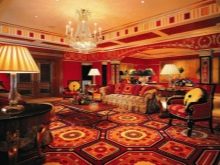


Chinese
The Chinese hall differs from the Arab one in less splendor, but with a greater emphasis on philosophy and worldview.This solution is suitable for those who seek to express their inner world in the living room. State-of-the-art technological solutions and associated materials are categorically unacceptable. But paper wallpaper and decorative plaster with painting fully comply with the canon. Important: individual drawings are deeply symbolic, and the choice of their subjects must be approached responsibly.
In a Chinese living room, use as much red as possible. Very often it is combined with golden and black paints.




Japanese
The Japanese interior design of the living room also deserves attention. It is characterized by conciseness and simultaneous clarity. A real Japanese room is always as strict as a samurai prepared for battle.
The slightest deviation from the canons will lead to the destruction of the entire composition. But it is precisely thanks to this rigor that it is not difficult to create it. All that is needed is scrupulous execution of the basic rules. The Japanese style differs from the minimalistic one by the use of floral themes and softened pastel colors. Be sure to take care of maximum lighting and laconic presentation of the room.




As for the materials, they are invariably selected in Japanese rooms with an emphasis on natural origin and appearance. Objects with very complex elaborate shapes cannot be used. The only exception is left for wall panels. It is advisable to use tatami mats. Important: authentic Japanese mats have "squares" with split corners - this is the traditional mythology.




Classic interior solutions in the Japanese spirit can be very diverse. However, in any case, they express the concept of yin and yang balance. The finishing is necessarily done with natural textures. The interior uses:
- engravings;
- ikebana;
- vases;
- island style boxes;
- floor lamps made of paper.




Indian
It is quite rare to find the design of the living room in the Indian style. This variant of ethnic design has been repeatedly changed and corrected. In the past, it was simple and functional, but today the proper Indian living room must be sophisticated and luxurious. Characteristic features will be:
- bright colors;
- handmade wooden furniture;
- carved screens;
- wrought iron and ivory inlays;
- teak beds, tables;
- textiles with floral patterns.

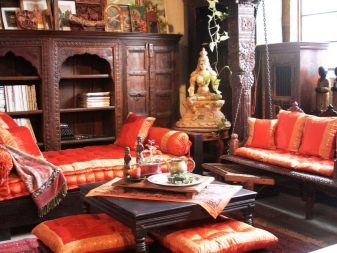


To further deepen the authenticity of the composition, the use of incense sticks and dried plant incense helps. The color varies from soft peach to rich purple or turquoise. Gold or mother-of-pearl walls will help to make the room more luxurious. The ceiling is decorated with multi-level structures with the addition of textile fabrics.
It is not necessary to lay the floor in the Indian living room with stone or ceramic tiles. It is sufficient to use a cheaper laminate with traditional ornamentation.




Korean
Another branch of the oriental interior is Korean. Like other styles originating from the foreign Far East, it is characterized by a minimalist format. A mandatory feature of this approach is filling the room with air and saving as much free space as possible.

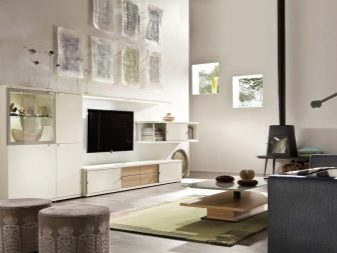
Korean classics involve the use of strictly one paint without drawings. Application is allowed:
- light gray;
- pale pistachio;
- light white;
- pale yellow.



From finishing materials, it is advised to use wallpaper, decorative plaster or canvas reproducing natural fabric. Furniture in a Korean living room should be kept low. An indispensable component will be a rectangular wooden table with a height of 0.3-0.5 m. Furniture items can be made with plant or animalistic motives.



Classical Korean style involves the use of images of a crane, a deer, and a pine tree.They will look even more attractive on black furniture. It is advised to use:
- silk embroidered silk;
- expressive picturesque panels;
- replicas of calligraphic compositions;
- live decorative flowers.



Design options
The description of styles is endless. But it would be much more correct to look at specific options for their implementation. The photo shows an exquisite living room in an Arabian spirit. Multi-colored sofas, a table imitating a fountain, a ceiling lamp with pendant decor add splendor. Adaptation to European interiors is expressed in the use of a painting on the wall (painting, as you know, is strongly condemned by Islam).

And here a completely different - Japanese - approach is embodied. Large hieroglyphs are used in the design of one of the walls. Low furniture of discreet tones fully fits into the style. The decor is used in relatively small quantities. The mirrored multi-level ceiling only adds to the charm.
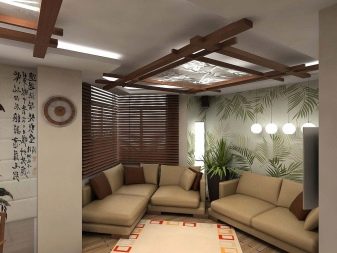

Something like this might look like an exemplary living room in the Chinese key. Its designers have tried to use old-fashioned dark wood furniture. Curved elements and traditional ornaments only add color. Symmetrical lamps with graceful shades express the orderliness characteristic of the Chinese tradition. The light back wall turns out to be a very good backdrop.
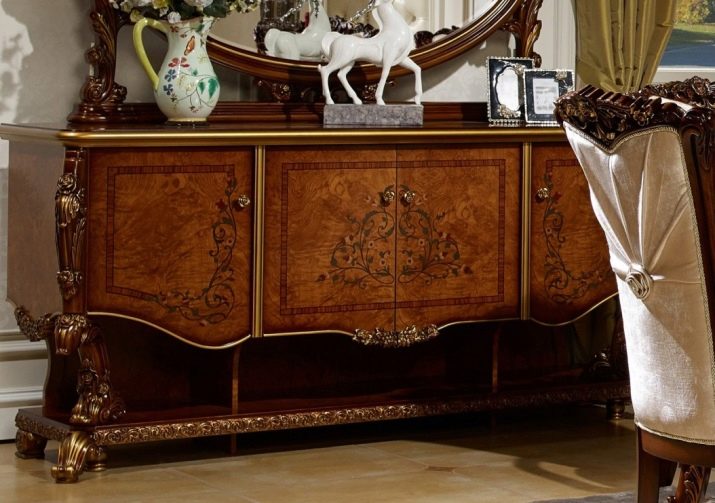
An Indian living room with a red wall might look just like that. The elegant dark wood furniture matches the general orientation of oriental interiors. Geometric ornaments on one of the chairs add grace. A very light floor allows you to compensate for the excess of dark tones in other parts of the room. As with the Chinese style, clear symmetry is maintained.

This is how an exemplary Korean living room might look. A very light color predominates, one wall, in general, is decorated in pure white. Plank floors and small paintings on the walls add authenticity. For the same purpose, mats and pillows are used. The designers took care of the maximum natural light.

Living room decoration in Chinese style in the video below.








